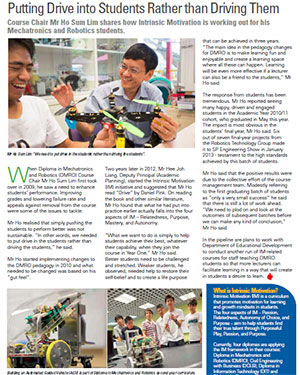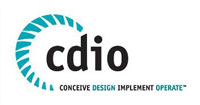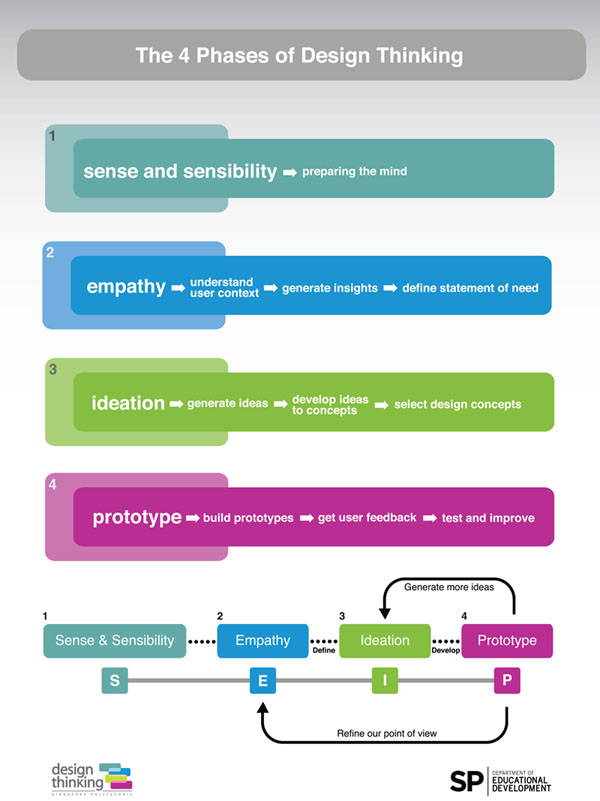DIPLOMA IN MECHATRONICS & ROBOTICS (S73)
TEACHING METHODS
Putting Drive into Students Rather than Driving Them
When Diploma in Mechatronics and Robotics (DMRO) course chair, Mr Ho Sum Lim took over the course in 2009, he realised the need to do something the students themselves would want very much. He wanted to improve the grades of his students and lower the failure rates and the number of appeals against removal from the course. There was a need to inspire the students from Year 1, especially the less motivated ones, if they were to rediscover their passion and unleash their potential.
Mr Ho began implementing changes to the DMRO pedagogy in 2010/2011 based on his “gut feel”. When SP started the IM initiative in 2012, Mr Ho found that what he had already put into practice based on his “gut feel” actually falls into the key aspects of IM. Thus, the DMRO course became the pilot course for the implementation of the IM teaching method. The pioneer batch of 80 DMRO students who underwent the pilot Intrinsic Motivation teaching method graduated in May 2013.
Click on the image below to read more.

CDIO

Singapore Polytechnic (SP) is the first educational institution in Asia to be a Conceiving – Designing - Implementing - Operating (CDIO) collaborator in 2004 and has implemented the CDIO framework in its engineering courses successfully in 5 faculty schools and 15 diplomas since 2007. CDIO represents the 4 key stages of most engineering activities and is an engineering education framework developed by Massachusetts Institute of Technology (MIT) and adopted by more than 50 universities worldwide.
The framework focuses strongly on student projects and features active and collaborative learning experiences in both classrooms and workshops or laboratories. It provides students with an education stressing engineering fundamentals set in a context of Conceiving, Designing, Implementing and Operating real-world systems and products.
Developed with input from industry, engineers, alumni and faculty, CDIO equips our engineering students with the technical knowledge, personal and professional skills, and design build experiences to be adaptable and resourceful, good communicators, work comfortably within a team, and have a good blend of theoretical knowledge and practical skills to develop solutions for engineering problems.
In 2010, SP was awarded the Excellence in Education and Training in Chemical Engineering by IChemE (S’pore) for adopting the CDIO framework to deliver the best educational experience to students.
Design Thinking

To be relevant in the workplace, our graduates have to be able to conceive innovative solutions based on real user needs. The Design Thinking process of empathy study of users, ideation, and quick prototyping and co-creation is adopted to strengthen students’ conceiving and designing skills of the CDIO framework.
Recommended by Singapore’s Economic Strategies Committee, Design Thinking uses a range of skills and practices to identify unmet needs and opportunities to create solutions that matter to people. This methodology has been successfully applied not only to technology problems, but also to businesses and social innovations.
“Design thinking is a human-centered approach to innovation that draws from the designer's toolkit to integrate the needs of people, the possibilities of technology, and the requirements for business success.” —Tim Brown, president and CEO
Design Thinking is especially useful for solving challenging problems in our constantly changing world today. Problems which are ill-defined with incomplete, contradictory and changing requirements that are often difficult to recognize and which are interrelated in complex ways. Globalisation, climate change, water security, aging populations and healthcare challenges are just some of the complex problems that we and our students will face in this 21st century.
In 2010, Singapore Polytechnic (SP) started to implement Design Thinking into their organisation. SP created its own Design Thinking framework which consists of four phases and trained lecturers in design thinking workshops and embark on design thinking projects in studio settings.

The implementation of design thinking in curriculum takes form in the development of multi-disciplinary projects (MDP) where 2nd year students collaborate with other students from different disciplines to work on real-world issues using the design thinking approach. Through MDP, students not only learn the skills of design thinking but also learn to work in teams just as they would after they graduate.

Students work on issues of topics which range from elderly care, health care, social spaces to social innovation. The MDP see students presenting their various prototypes and good solutions will later continue as students’ final year projects.
Intrinsic Motivation
The IM teaching method is based on the works of psychologists and human motivation experts such as Edward Deci, Tom and David Kelley etc. The key focus is to incorporate curriculum activities that encourage competence, relatedness, autonomy, purpose, and the cultivation of a growth mindset.
With close to 16,000 students, SP recognises that we have a diverse student population with a wide range of interests and abilities.
What are the main components of IM?
- Nurturing a growth mindset
Established research shows that a person’s learning attainment is very much based on embracing personal effort, taking on challenges, persisting in the face of difficulties, when working towards mastery of learning goals.
How is the IM teaching method implemented in the DMRO course?
DMRO adopted the inspire (Year 1), integrate (Year 2) and invent (Year 3) curriculum and infuses the Intrinsic Motivation teaching method as follows:
inspire through Purposeful Play in Year 1: inspire aims to instil the desire to Be and to Learn in students. Students are given autonomy to learn through play. Activities include experimenting with engineering objects (e.g., building the catapult machine), designing their own products and entering local robotic competitions. The emphasis was on students having both a choice in what they do and experiencing fun in the learning process.
Possibility and Meaning in Year 3: Students build upon their foundational knowledge and skills to choose a project of their own interest that has special meaning for them. A learning space is provided within which there are learning spaces for co-creation, facility, play, knowledge and sharing. Relatedness among students, and between staff and students is further strengthened when they work on the final year capstone project.